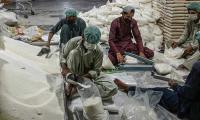Karachi
The infant mortality rate in Sindh was recorded at 82 deaths per 1,000 live births (8.2 percent) and under-five mortality rate at 104 per 1,000 (10.4 percent), according to the Sindh Multiple Indicator Cluster Survey (MICS), 2014.
Besides, around four of 10 children in the province under five are underweight and 17 percent are classified as severely underweight.
The findings of the MICS, 2014 were revealed in a presentation by planning and development department to Chief Minister Syed Qaim Ali Shah. The survey is designed to provide estimates for more than 100 indicators on situation of children in the province.
Briefing the meeting, ACS (Development) Mohammad Waseem said it was one of the largest surveys in Sindh with a sample size of 19,360 households.
He added that the survey conducted from January to August 2014 was part of the fifth global round of the Multiple Indicator Clusters Surveys programme.
The senior minister for finance and planning and development said the MICS was a unique source of information which would serve as a baseline for researchers, policy makers, planners, and individuals and provide evidence-based data for decision making.
The survey was conducted by the Bureau of Statistics in collaboration with Unicef and the Pakistan Council of Research in Water Resources. The Pakistan Bureau of Statistics provided the sampling frame.
Bureau of Statistics additional secretary Shahnawaz Jaskani said in recent years, the people of Sindh had experienced two record-breaking floods and rains.
The children may have been disproportionately affected and Sindh MICS 2014 shows that the infant mortality rate is 82 deaths per 1,000 live births and the under-five mortality rate is 104 deaths per 1,000.
Nutrition
About the nutritional status, the report states that more than four out of 10 children under the age of five are underweight and 17 percent are classified as severely underweight. Almost half of the children under five years (48 percent) are stunted or short for their age and one quarter (24 percent) are severely stunted.
The report reveals that 15 percent of the children are thin for their height and only one percent of are overweight or too heavy for their height.
Vaccination
The report states that immunisation is the key to preventing diseases among children. Over all 35 percent of children aged between 12 and 23 months received all the recommended vaccines, reflecting improvement in the last few years in comparison with the findings of the survey conducted in 2012.
Similarly, an improvement has been witnessed in measles vaccine coverage which is 53 percent against 45 percent in 2012.
Water and sanitation
Around 90 percent of the population has access to improved sources of drinking water while it was hardly 80 percent in the survey conducted in 2003.
Three percent of households use drinking water indicating arsenic contamination while 39 percent of houses use drinking water indicating E.coli contamination.
Reproductive health
The fertility rate in the province is four children per woman while it was 5.3 children per woman as per the findings of the 2003-04 survey.
Around 29 percent of married women use contraceptives.
Almost 80 percent of married women receive antenatal care from a skilled provider which is almost 100 percent improvement in the last decade in comparison with the findings of the MICS 2003-o4 when it was recorded at 42 percent.
The prevalence of institutional deliveries has also considerably increased from 42 percent in DHS 2006-07 to 62 percent in the current survey.
Education and literacy
Over half or 52.3 percent of girls aged between 15 and 24 years in the province are literate. 45.2 percent of school-age children currently attending primary education or higher education with a modest improvement against 39 percent in the MICS 2003-o4.
The report further states that for every 100 boys attending primary schools, 86 girls are also attending and 81 girls for every 100 boys are attending secondary school.
Child protection
Around 29.1 percent of births of children under five are registered. Over 26 percent of the children aged between five and 17 years are involved in labour.
About 81 percent of children between one and 14 years experience psychological aggression, physical punishment or violent behaviour as a method of discipline.
Around 16.3 percent girls aged between 15 and 19 years are married.
However, there seems to be a decline in the number of girls being married off before the age of 15.
The data reflects that 17.5 percent of women in the age group of 45 and 49 years had married before the age of 15 compared with four percent of women between 15 and 19 years.
The report giving an interesting revelation on access to mass media states that overall 70.4 percent of women either watch TV, read newspapers or magazines or listen to the radio at least once a week.
The report states that among the women aged between 15 and 24, almost 21 percent used a computer during a one year period before the survey and 13.1 percent used a computer at least once a week during the past month.
Around 13 percent of young women had used internet during the past few years. Only 8.1 of young women used the social media at least once a week during the last month.
More than half of the women in rich households used social media compared with less than one percent in poor households.
A test tube can be seen in this picture with the name Hepatitis C on it. — Pixabay/FileSindh has screened over one...
The representational image shows dilapidated buildings in Karachi. — PPI/FileIn the wake of the recent collapse of a...
The representational image shows a person trying to open the door of a car. — Unsplash/FileThe Anti-Vehicle Lifting...
indh Senior Minister for Information and Transport Sharjeel Inam Memon speaks during a meeting on April 28, 2024. —...
The representational image shows a police mobile van. — APP/FileThe Special Investigation Unit of the police has...
The representational image shows a woman carrying her infant child in her hand. — Unsplash/FileThe federal...







